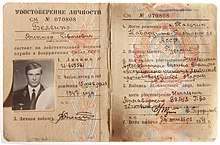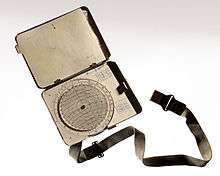Viktor Belenko
Viktor Ivanovich Belenko (Russian: Виктор Иванович Беленко, born 15 February 1947) is a former Soviet pilot who defected to the West while flying his MiG-25 jet fighter (NATO reporting name: "Foxbat") and landed in Hakodate, Japan. George H. W. Bush, the Director of Central Intelligence at the time, called the opportunity to examine the plane up close an "intelligence bonanza" for the West.[1] Belenko later became a U.S. aerospace engineer.
Viktor Belenko | |
|---|---|
Russian: Виктор Иванович Беленко | |
.jpg) Viktor Belenko Soviet military identification photo | |
| Born | 15 February 1947 Nalchik, Russian SFSR |
| Occupation | Fighter pilot |
| Known for | Defecting to the U.S. with MiG-25 in 1976 |

Early life and defection

Belenko was born in Nalchik, Russian SFSR, in a Russian family (his passport states his nationality as Russian). Lieutenant Belenko was a pilot with the 513th Fighter Regiment, 11th Air Army, Soviet Air Defence Forces based in Chuguyevka, Primorsky Krai. On 6 September 1976, he successfully defected to the West, flying his MiG-25 jet fighter to Hakodate, Japan.[2]
This was the first time that Western experts were able to get a close look at the aircraft, and it revealed many secrets and surprises. His defection caused significant damage to the Soviet Air Force.[3] Belenko was granted asylum by U.S. President Gerald Ford, and a trust fund was set up for him, granting him a very comfortable living in later years. The U.S. Government debriefed him for five months after his defection, and employed him as a consultant for several years thereafter. Belenko had brought with him the pilot's manual for the MiG-25, expecting to assist U.S. pilots in evaluating and testing the aircraft.
Belenko was not the only pilot to have defected from the Soviet Union in this way, nor was he the first such to defect from a Soviet-bloc country. He may have been aware of the U.S. government's policy of awarding large cash prizes to defecting pilots of communist countries . In March[4] and May 1953,[5] two Polish Air Force pilots flew MiG-15s to Denmark. Later in 1953, North Korean pilot No Kum Sok flew his MiG-15 to a U.S. air base in South Korea;[6] this MiG is in the permanent collection of the National Museum of the U.S. Air Force, displayed in its original owner markings.[7] Later, Soviet Captain Aleksandr Zuyev flew his MiG-29 to Trabzon, Turkey on 20 May 1989.[8] That MiG-29 was promptly returned to the Soviets.[9]
Aftermath
The MiG-25's arrival in Japan was a windfall for Western military planners. The Japanese government originally only allowed the United States to examine the plane and do ground tests of the radar and engines, but subsequently invited the U.S. to examine the plane extensively. It was dismantled for this purpose in Japan.[10] The plane was moved by a US Air Force C-5 Galaxy cargo aircraft from Hakodate to Hyakuri Air Base on 25 September, and by this time experts had determined that the plane was an interceptor, not a fighter-bomber, which was a welcome reassurance for Japanese defense planners.[11]
The Japanese government laid out a plan on 2 October to return the aircraft in crates from the port of Hitachi and bill the Soviets US$40,000 for crating services and airfield damage at Hakodate.[12] The Soviets unsuccessfully tried to negotiate a return via one of their own Antonov An-22 aircraft and attempted to organize a rigorous inspection of the crates, but Japan refused both demands and the Soviets finally submitted to the Japanese terms on 22 October.[13] The aircraft was moved from Hyakuri to the port of Hitachi on 11 November on a convoy of trailers. It left in 30 crates aboard the Soviet cargo ship Taigonos on 15 November 1976 and arrived about three days later in Vladivostok.[14] A team of Soviet technicians had been allowed to view subassemblies at Hitachi, and upon finding 20 missing parts,[15] one being film of the flight to Hakodate,[14] the Soviets attempted to charge Japan US$10 million. Neither the Japanese nor Soviet bill is known to have been paid.[12]
A senior diplomat described the Soviet position as "sulky about the whole affair".[16] The CIA concluded at the time that "both countries seem anxious to put the problem behind them" and speculated that the Soviets were reluctant to cancel a series of upcoming diplomatic visits because "some useful business is likely to be transacted, and because the USSR, with its political standing in Tokyo so low, can ill afford setbacks in Soviet–Japanese economic cooperation."[17]
Post-defection life in the United States
In 1980, the U.S. Congress enacted S. 2961, authorizing citizenship for Belenko. It was signed into law by President Jimmy Carter on 14 October 1980, as Private Law 96-62.[18][19]
After his defection, he co-wrote a 1980 autobiography, MiG Pilot: The Final Escape of Lieutenant Belenko with Reader's Digest writer John Barron.[20]
While residing in the United States, Belenko married a music teacher from North Dakota, Coral, and fathered two sons, Tom and Paul. He later divorced. He also has a son from his first marriage. Belenko has never divorced his Russian wife.[21] After the breakup of the Soviet Union, he visited Moscow in 1995 on business.[22]
Belenko almost never appears in interviews. However, in a brief and informal bar interview in 2000 where he posed for pictures and responded to questions, he stated that he was happy in the United States, remarking that "[Americans] have tolerance regarding other people's opinion. In certain cultures, if you do not accept the mainstream, you would be booted out or might disappear. Here we have people, you know, who hug trees, and people who want to cut them down -- and they live side by side!"[23][24]
The Soviet Union repeatedly spread false stories about Belenko being killed in a car accident, returning to Russia, being arrested and executed or otherwise brought to "justice".[25]
See also
- Munir Redfa
- List of Cold War pilot defections
- List of Eastern Bloc defectors
References
- INTELLIGENCE: Bonanza or Bust? Time Magazine, Monday, 1 November 1976
- Aviation Week & Space Technology. 105. McGraw-Hill. 1976. p. 120.
- (in Russian) Предатель – Беленко Виктор Иванович. tkachenko.in.ua
- Mr. Mig: And the Real Story of the First Migs in America, Paul T. Entrekin Retrieved 27 August 2017
- Skaarup, Harold Canadian MiG Flights Retrieved 27 August 2017
- Rowe, Kenneth H. (No Kum-sok); Osterholm, J. Roger (1996). A MiG-15 to Freedom. McFarland & Company Inc. ISBN 0-7864-0210-5. Retrieved 22 September 2013.
- Mikoyan-Gurevich MiG-15bis National Museum of the U.S. Air Force Retrieved 25 August 2017
- MiG returned to Soviet Union, United Press International, 21 May 1989.
- MiG returned to Soviet Union, United Press International, May 21, 1989.
- New York Times, 22 September 1976, column 4.
- UNCLAS State Message 239736, U.S. State Department, 27 September 1976.
- MiG Pilot: the Final Escape of Lt. Belenko, John Barron, 1980, ISBN 0-380-53868-7.
- JAPAN-SOVIET RELATIONS: NEGOTIATIONS FOR RETURN OF MIG-25, TOKYO 15888 221325Z (Confidential), U.S. State Department, 22 October 1976.
- Flight International, 27 November 1976, p. 1546.
- SHARING MIG 25 INFORMATION WITH THIRD COUNTRIES, TOKYO 220903Z NOV 76 (Secret), U.S. State Department, 22 November 1976.
- JAPAN-SOVIET RELATIONS: NEGOTIATIONS FOR RETURN OF MIG-25, TOKYO 16354 021113Z (Confidential), U.S. State Department, 2 November 1976.
- NATIONAL INTELLIGENCE DAILY CABLE, Monday 8 November 1976 (Top Secret), Central Intelligence Agency, 1976.
- 96th Cong. S.2961, A bill for the relief of Viktor Ivanovich Belenko, Bill Summary and Status.
- An act for the relief of Viktor Ivanovich Belenko, 94 Stat. 3599. GPO's Federal Digital System.
- "'Skyhook' and other CIA spyware". San Francisco Chronicle. 16 October 2012. Retrieved 25 July 2017.
- Aleksandr Kots (26 September 2006) Он сел на истребитель и сбежал из СССР. Komsomolskaya Pravda
- (in Russian) 25 лет назад советский военный летчик лейтенант Виктор Беленко угнал новейший истребитель "Миг-25" с приморской авиабазы в Соколовке в Японию. Vladivostok News (7 September 2001)
- "Oshkosh". www.chrisdixonreports.com.
- Reedstrom, Karen (November 1996). "Vikto Belenko". Full Context. Archived from the original on 10 October 2017.
- Савка, Ольга (7 November 2003). "A Story Not About A Hero".
Further reading
- MiG Pilot: the Final Escape of Lt. Belenko, by John Barron, 1980, ISBN 0-380-53868-7
External links
| Wikimedia Commons has media related to Viktor Belenko. |
- "1996 interview with Belenko". Archived from the original on 11 January 2001.
- (in Russian) Article 'Mission "Foxbat': Almost 30 years ago Senior Lieutenant Belenko hijacked the Mig-25 fighter from the Sokolovka air base to Japan." (Google translation)
- Article on Belenko at Everything2
- Chris Dixon. A Reporter's Online Notebook: Victor Belenko.